2023届高三英语二轮复习:词类名动形副冠代介连 课件(57张ppt)
文档属性
| 名称 | 2023届高三英语二轮复习:词类名动形副冠代介连 课件(57张ppt) | 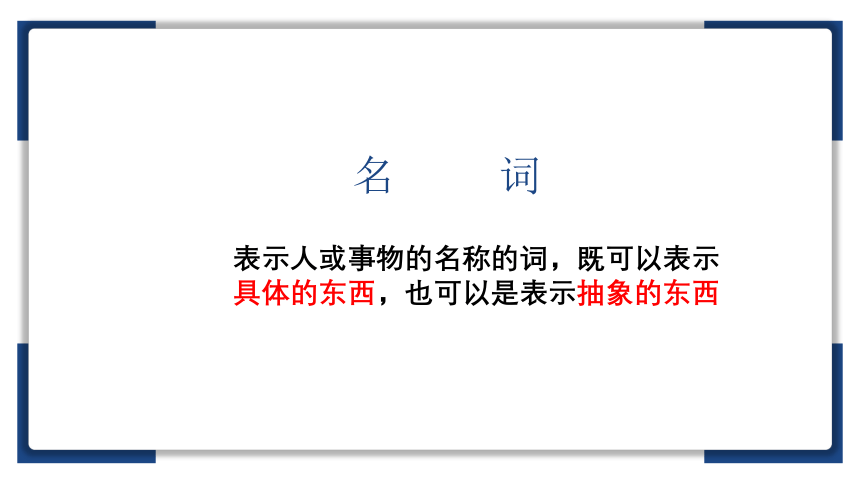 | |
| 格式 | pptx | ||
| 文件大小 | 283.9KB | ||
| 资源类型 | 教案 | ||
| 版本资源 | 通用版 | ||
| 科目 | 英语 | ||
| 更新时间 | 2022-10-31 12:40:58 | ||
图片预览

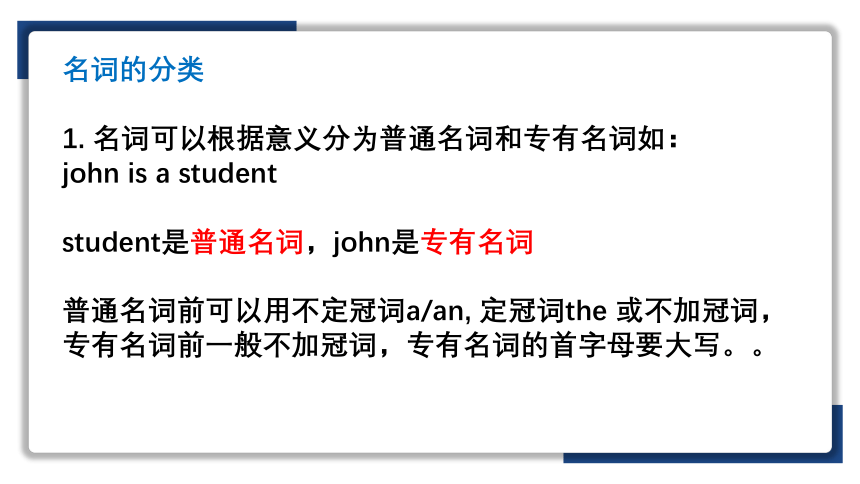
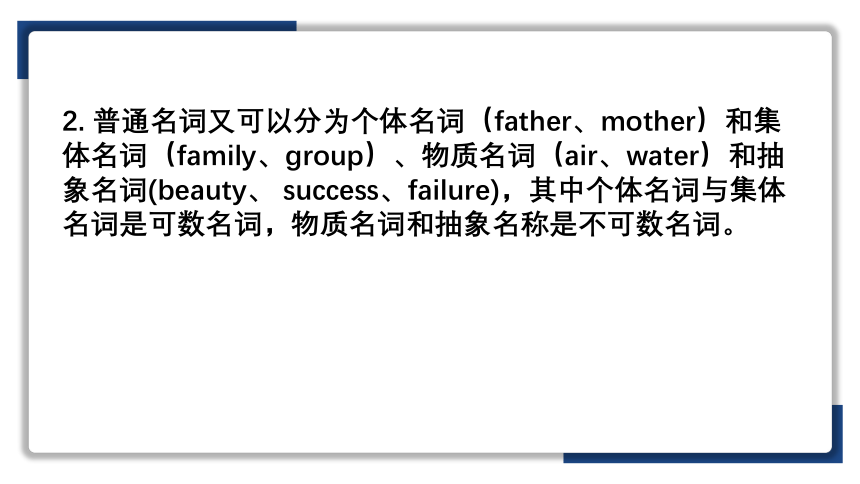

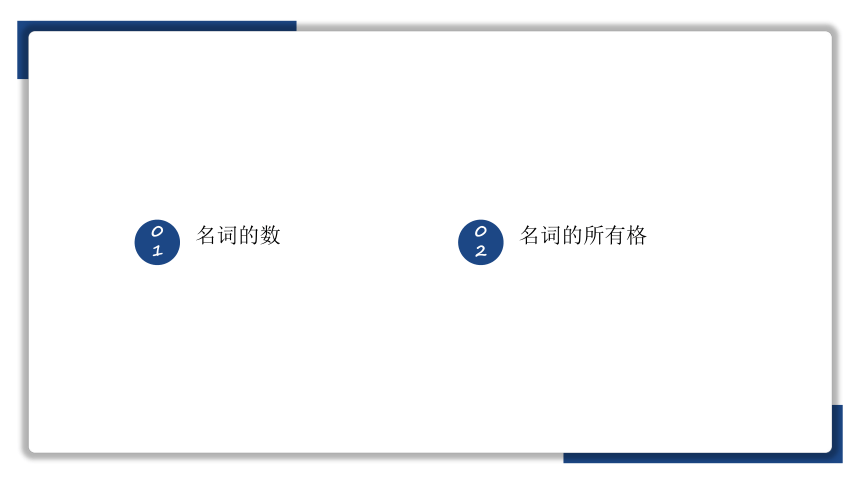

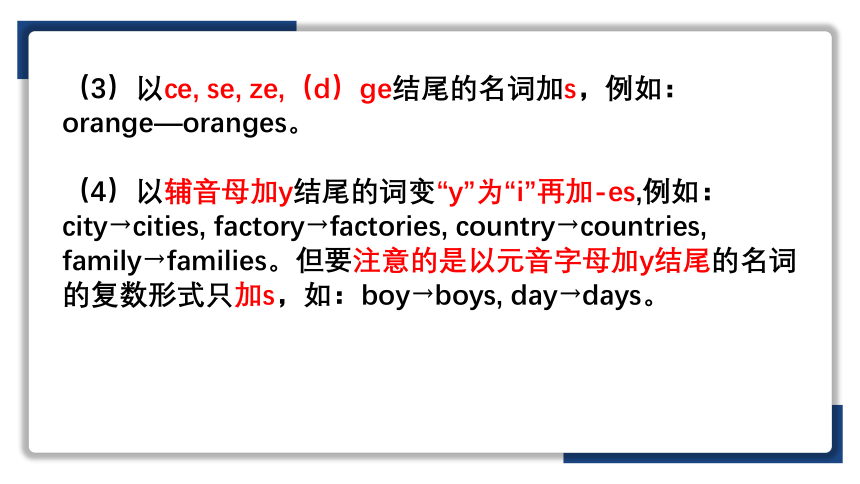
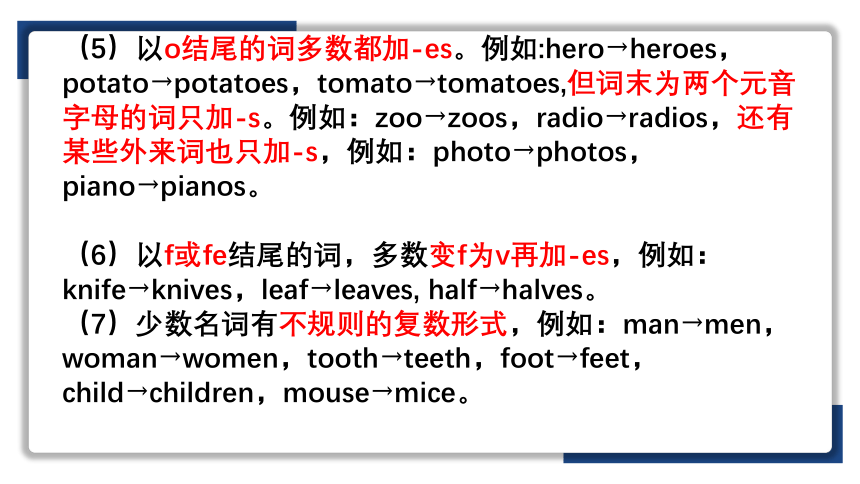


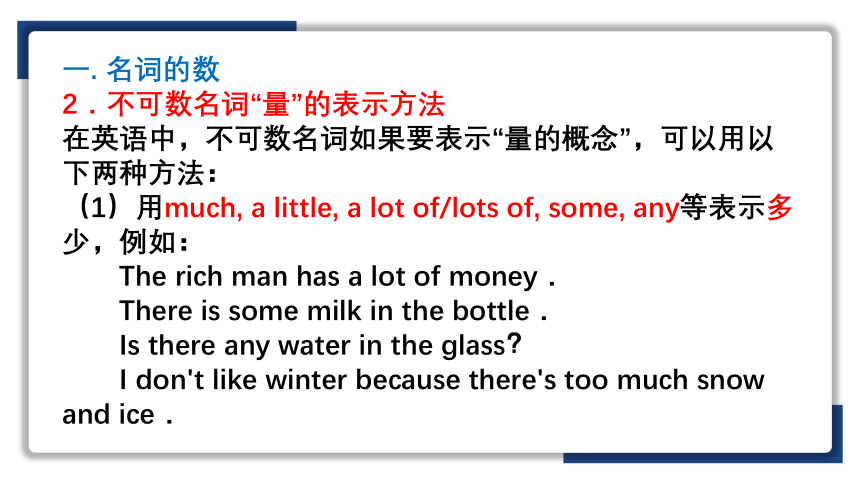

文档简介
(共57张PPT)
名词
表示人或事物的名称的词,既可以表示具体的东西,也可以是表示抽象的东西
名词的分类
1. 名词可以根据意义分为普通名词和专有名词如:
john is a student
student是普通名词,john是专有名词
普通名词前可以用不定冠词a/an, 定冠词the 或不加冠词,专有名词前一般不加冠词,专有名词的首字母要大写。。
2. 普通名词又可以分为个体名词(father、mother)和集体名词(family、group)、物质名词(air、water)和抽象名词(beauty、 success、failure),其中个体名词与集体名词是可数名词,物质名词和抽象名称是不可数名词。
3. 专有名词专有名词是表示人名、地名、团体、机构、组织等的专有名词,多为独一无二的事物。
01
名词的数
02
名词的所有格
一. 名词的数
1.单数和复数
可数名词有单数和复数两种形式。复数形式通常是在单数形式后加词尾“-s”构成,其主要变法如下:
(1)一般情况在词尾加-s,例如:book→books,girl→girls,boy→boys,pen→pens,doctor→doctors, boy→boys。
(2)以s,x,ch,sh,结尾的词加-es,例如:bus→buses,class→classes
box→boxes,watch→watches,brush→brushes。
(3)以ce, se, ze,(d)ge结尾的名词加s,例如:orange—oranges。
(4)以辅音母加y结尾的词变“y”为“i”再加-es,例如:city→cities, factory→factories, country→countries, family→families。但要注意的是以元音字母加y结尾的名词的复数形式只加s,如:boy→boys, day→days。
(5)以o结尾的词多数都加-es。例如:hero→heroes,potato→potatoes,tomato→tomatoes,但词末为两个元音字母的词只加-s。例如:zoo→zoos,radio→radios,还有某些外来词也只加-s,例如:photo→photos,piano→pianos。
(6)以f或fe结尾的词,多数变f为v再加-es,例如:knife→knives,leaf→leaves, half→halves。
(7)少数名词有不规则的复数形式,例如:man→men,woman→women,tooth→teeth,foot→feet,child→children,mouse→mice。
【注意】与man和woman构成的合成词,其复数形式也是-men和-women。例如:an Englishman,two Englishmen。
但German不是合成词,故复数形式为 Germans;
man, woman等作定语时,它的单复数以其所修饰的名词的单复数而定,如:men workers, women teachers。
有个别名词单复数一样,例如:Chinese,Japanese,sheep,deer,fish等。但当fish表示不同种类的鱼时,可以加复数词尾。
(8)单数形式但其意为复数的名词有:people, police等。
(9)数词+名词作定语时,这个名词一般保留单数形式,中间加连字符。例如 an 8-year-old girl, a ten-mile walk。
(10)还有些名词仅有复数形式,如:trousers,clothes,chopsticks,glasses,goods,ashes,scissors,compasses。
(11)只用作单数的复数形式的名词有:
科学名词:physics, mathematics/maths
游戏名称:bowls
专有名词:the United States, Niagara Falls
其他名词:news, falls
一. 名词的数
2.不可数名词“量”的表示方法
在英语中,不可数名词如果要表示“量的概念”,可以用以下两种方法:
(1)用much, a little, a lot of/lots of, some, any等表示多少,例如:
The rich man has a lot of money.
There is some milk in the bottle.
Is there any water in the glass?
I don't like winter because there's too much snow and ice.
(2)用a piece of 这类定语,例如:
a piece of paper a piece of wood a piece of bread
a bottle of orange a glass of water(milk) a cup of tea.
a cup of tea a bag of rice three bags of rice
如果要表示“两杯茶”、“四张纸”这类概念时,在容器后加复数,例如:
two cups of tea
four pieces of paper
three glasses of water
不可数名词也可用a lot of, lots of, some, any, much等来修饰。
二. 名词的所有格
名词所有格,用来表示人或物的所有,以及领属关系。
1. 表示有生命的名词的所有格其单数形式是加 's,其复数形式是s',例如:a student's room, students' rooms, father's shoes。
2. 如其结尾不是s的复数形式仍加 's,如:Children's Day。
3. 在表示时间、距离、长度、重量、价格、世界、国家等名词的所有格要用 's,例如:a twenty minutes' walk,ten miles' journey,a boat's length,two pounds' weight, ten dollars' worth。
4. 无生命名词的所有格则必须用of结构,例如:a map of China,the end of this term,the capital of our country, the color of the flowers。
5. 双重所有格,例如:a friend of my father's。
【注意】
如果两个名词并列,并且分别有 's,则表示“分别有”,例如:
John's and Mary's rooms(约翰和玛丽各有一间,共两间)
Tom's and Mary's bikes(两人各自的自行车。
两个名词并列,只有一个's,则表示“共有”,
例如:John and Mary's room(约翰和玛丽共有一间);
Tom and Mary's mother(即Tom与Mary是兄妹)。
形容词
用以修饰或限定名词或代词的词
形容词的用法
(1) 形容词在句中作定语, 表语, 宾语补足语。 例如:
Our country is a beautiful country. (作定语)
The fish went bad. (作表语)
We keep our classroom clean and tidy. (作宾语补足语)
(2) 形容词修饰something, anything, nothing, everything等不定代词时,形容词放在名词后面。
I have something important to tell you.
Is there anything interesting in the film.
(3) 用 and 或 or 连接起来的两个形容词作定语时一般把它们放在被修饰的名词后面。起进一步解释的作用。
Everybody, man and woman, old and young, should attend the meeting.
You can take any box away, big or small.
(4) the+形容词表示一类人或物
The rich should help the poor.
副词
在词汇中表现出来的一种词性
在词汇中表现出来的一种词性,在句子中,我们经常会用副词来对句子中的动词、动词性词组,又或是整个句子进行添加,形容、修饰。中文语法中,副词被运用在句子中时,一定带有“地”。
副词的用法
(1) 副词在句中可作状语,表语和定语。
He studies very hard. (作状语)
Life here is full of joy. (作定语)
When will you be back (作表语)
.
副词按其用途和含义可分为下面五类:
1)时间副词
时间副词通常用来表示动作的时间。常见的时间副词有:now today, tomorrow, yesterday, before, late, early, never, seldom, sometimes, often, usually, always等。例如:
He often comes to school late.
What are we going to do tomorrow
He is never been to Beijing.
.
2)地点副词
地点副词通常用来表示动作发生的地点。常见的地点副词有:here, there, inside, outside, home, upstairs, downstairs, anywhere, everywhere, nowhere, somewhere, down, up, off, on, in, out等。例如:
I met an old friend of mine on my way home.
He went upstairs.
Put down your name here.
.
3) 方式副词
方式副词一般都是回答“怎样的?”这类问题的,其中绝大部分都是由一个形容词加词尾-ly构成的, 有少数方式副词不带词尾-ly, 它们与形容词同形。常见的方式副词有:anxiously, badly, bravely, calmly, carefully, proudly, rapidly, suddenly, successfully, angrily, happily, slowly, warmly, well, fast, slow, quick, hard, alone, high, straight, wide等。例如:
The old man walked home slowly.
Please listen to the teacher carefully.
The birds are flying high.
He runs very fast.
.
4)程度副词
程度副词多数用来修饰形容词和副词,有少数用来修饰动词或介词短语。常见的程度副词有:much, (a) little, a bit, very, so, too, enough, quite, rather, pretty, greatly, completely, nearly, almost, deeply, hardly, partly等。
例如:
Her pronunciation is very good.
She sings quite well.
I can hardly agree with you.
.
5)疑问副词
是用来引导特殊疑问句的副词。常见的疑问副词有:how, when, where, why等。例如:
How are you getting along with your studies
Where were you yesterday
Why did you do that
.
(2)副词在句中的位置
1)多数副词作状语时放在动词之后。如果动词带有宾语,则放在宾语之后。例如:
Mr Smith works hard.
She speaks English well.
2)频度副词作状语时,通常放在行为动词之前,情态动词,助动词和be动词之后。例如:
He usually gets up early.
3)程度副词一般放在所修饰的形容词和副词的前面, 但enough作副词用时,通常放在被修饰词的后面。例如:
It is a rather difficult job.
He runs very fast.
He didn’t work hard enough.
.
3.形容词和副词的比较级和最高级
(1) 两个人或事物的比较时(不一定每一方只有一个人或一个事物),用比较级。
Our teacher is taller than we are.
The boys in her class are taller than the boys in your class.
(2)“The+形容词比较级..., the+形容词比较级...”表示“越... 就越...”。
The more you study, the more you know.
(3) “形容词比较级 + and + 形容词比较级”, 表示 “ 越来越...”。
It's getting hotter and hotter.
(4) 主语+谓语(系动词)+as+形容词原形+as+从句。表示两者对比相同。
This box is as big as mine.
(5) 形容词和副词最高级(the + adj.est)
Shanghai is one of the biggest cities in China.
动词
一般用来表示动作或状态的词汇
1.动词的时态
(1)一般现在时的基本用法
I leave home for school at 7 every morning.
Shanghai lies in the east of China.
(2)一般过去时的用法:
ago yesterday the day before yesterday last week/year/night/month... in 1989 just now
I worked in that factory last year.
(3)一般将来时的用法: 表示将来的动作或状态
基本结构: will +do sth
be + going +to do sth
be to do sth
be about to do sth
He will go to see his mother.
I am going to fly to Beijing next week.
We are to meet the guests at the station.
They are about to leave.
(4)现在进行时的用法
定义:现在进行时的用法表示说话者说话时正在发生或者进行的动作
基本结构:be+V.ing
I am looking for my key.
(5)现在完成时的用法 :
定义:1. 表示在说话之前已经完成或刚完成的动作
2.表示动作从过去开始持续到现在,或者还有可能持续下去的动作或状态。
基本结构:have/has +done(过去分词)
eg. They have cleaned the classroom.
2.动词的语态
语态有两种:主动语态和被动语态。
(1)被动语态
1) 被动语态最基本的句型结构是: be +及物动词过去分词
The children were taken good care of by her.
3.及物动词与不及物动词
及物动词指后面可以加宾语的动词,如eat、like、enjoy…
Eg. I like cat.
不及物动词后面不可以直接加宾语,得放个介词在中间
比如:go, appear, come, arrive……
eg. I go to school by bus. (借助动词加宾语)
my teacher appears. (没有宾语)
4.无实义动词:助动词、系动词、情态动词
1)助动词:am; is; are; was; were;
do; does; did,
Have, has (have/has+ done)
2)系动词:be 动词(am/is/are/was/were)
表感官的:look; sound; taste; smell; feel
其他常见:seem ; appear; go; grow; become; keep; remain……
3)情态动词:can; could; may; might; need; would; will; shall; should……
冠词
用来说明名词指的人或事物。
冠词有三种:
零冠词:\
定冠词:the 表特指
不定冠词:a/an (A、I、E、O、U)
冠词的用法:
1)定冠词:the 表特指
the + n: the student 这个学生
the+ 形容词+n: the smart student 这个聪明的学生
2)不定冠词:a/an 表泛指
a/an + n: a student 一个学生或某个学生
a/an+ 形容词+n: a smart student
一个或某个聪明的学生
数词
基数词:数目
序数词:顺序
基数词:数目(1.2.3.4.5.6.7.8……)
one ;two ;three ;four; five ;six ;seven ;eight ;nine ;ten ; eleven ;twelve ;thirteen ;fourteen ;fifteen ……
序数词:顺序(第一;第二;第三;第四;第五…….)
first; second; third; fourth; fifth; sixth; seventh; eighth; ninth……
代词
人称代词:
I like table tennis. (作主语)
Do you know him (作宾语)
物主代词:
形容词性物主代词的作用相当于形容词,可在句中作定语。例如:
Our teacher is coming to see us.
This is her pencil-box.
名词性物主代词的作用相当于名词,在句中可用作主语、宾语和表语。
Our school is here, and theirs is there.(作主语)
--- Is this your English-book (作宾语)
---Yes, this is mine.
Our school is here, and theirs is there.
theirs= their school 他们学校
--- Is this your English-book
---Yes, this is mine.
mine=my English book.我的英语书
指示代词:
指示代词包括:this,that,these,those。
这个,那个,这些,那些
this和these一般用来指在时间或空间上较近的事物或人
2.that和those 则指时间和空间上较远的事物或人
反身代词:
英语中用来表示“我自己”,“你自己”,“他自己”,“我们自己”,“你们自己”等意义的代词称为反身代词,
连词:
用来连接词,短语,从句或句子的词叫连词。
(1)表并列关系的and, both…and, not only…but also, neither…nor等。
(2)表选择关系的or, either…or等。
(3)表转折关系的but, while等。
(4)表因果关系的for, so等。
连词:
(1)引导时间状语从句的after, before, when, while, as, until, till, since, as soon as等。
(2)引导条件状语从句的if, unless等。
(3)引导原因状语从句的because, as, since等。
(4)引导目的状语从句的so that, in order that等。
(5)引导让步状语从句的though, although, even if等。
(6)引导结果状语从句的so that, so…that, such…that等。
(7)引导比较状语从句的than, as…as等。
(8)引导名词从句的that, if , whether等。
名词
表示人或事物的名称的词,既可以表示具体的东西,也可以是表示抽象的东西
名词的分类
1. 名词可以根据意义分为普通名词和专有名词如:
john is a student
student是普通名词,john是专有名词
普通名词前可以用不定冠词a/an, 定冠词the 或不加冠词,专有名词前一般不加冠词,专有名词的首字母要大写。。
2. 普通名词又可以分为个体名词(father、mother)和集体名词(family、group)、物质名词(air、water)和抽象名词(beauty、 success、failure),其中个体名词与集体名词是可数名词,物质名词和抽象名称是不可数名词。
3. 专有名词专有名词是表示人名、地名、团体、机构、组织等的专有名词,多为独一无二的事物。
01
名词的数
02
名词的所有格
一. 名词的数
1.单数和复数
可数名词有单数和复数两种形式。复数形式通常是在单数形式后加词尾“-s”构成,其主要变法如下:
(1)一般情况在词尾加-s,例如:book→books,girl→girls,boy→boys,pen→pens,doctor→doctors, boy→boys。
(2)以s,x,ch,sh,结尾的词加-es,例如:bus→buses,class→classes
box→boxes,watch→watches,brush→brushes。
(3)以ce, se, ze,(d)ge结尾的名词加s,例如:orange—oranges。
(4)以辅音母加y结尾的词变“y”为“i”再加-es,例如:city→cities, factory→factories, country→countries, family→families。但要注意的是以元音字母加y结尾的名词的复数形式只加s,如:boy→boys, day→days。
(5)以o结尾的词多数都加-es。例如:hero→heroes,potato→potatoes,tomato→tomatoes,但词末为两个元音字母的词只加-s。例如:zoo→zoos,radio→radios,还有某些外来词也只加-s,例如:photo→photos,piano→pianos。
(6)以f或fe结尾的词,多数变f为v再加-es,例如:knife→knives,leaf→leaves, half→halves。
(7)少数名词有不规则的复数形式,例如:man→men,woman→women,tooth→teeth,foot→feet,child→children,mouse→mice。
【注意】与man和woman构成的合成词,其复数形式也是-men和-women。例如:an Englishman,two Englishmen。
但German不是合成词,故复数形式为 Germans;
man, woman等作定语时,它的单复数以其所修饰的名词的单复数而定,如:men workers, women teachers。
有个别名词单复数一样,例如:Chinese,Japanese,sheep,deer,fish等。但当fish表示不同种类的鱼时,可以加复数词尾。
(8)单数形式但其意为复数的名词有:people, police等。
(9)数词+名词作定语时,这个名词一般保留单数形式,中间加连字符。例如 an 8-year-old girl, a ten-mile walk。
(10)还有些名词仅有复数形式,如:trousers,clothes,chopsticks,glasses,goods,ashes,scissors,compasses。
(11)只用作单数的复数形式的名词有:
科学名词:physics, mathematics/maths
游戏名称:bowls
专有名词:the United States, Niagara Falls
其他名词:news, falls
一. 名词的数
2.不可数名词“量”的表示方法
在英语中,不可数名词如果要表示“量的概念”,可以用以下两种方法:
(1)用much, a little, a lot of/lots of, some, any等表示多少,例如:
The rich man has a lot of money.
There is some milk in the bottle.
Is there any water in the glass?
I don't like winter because there's too much snow and ice.
(2)用a piece of 这类定语,例如:
a piece of paper a piece of wood a piece of bread
a bottle of orange a glass of water(milk) a cup of tea.
a cup of tea a bag of rice three bags of rice
如果要表示“两杯茶”、“四张纸”这类概念时,在容器后加复数,例如:
two cups of tea
four pieces of paper
three glasses of water
不可数名词也可用a lot of, lots of, some, any, much等来修饰。
二. 名词的所有格
名词所有格,用来表示人或物的所有,以及领属关系。
1. 表示有生命的名词的所有格其单数形式是加 's,其复数形式是s',例如:a student's room, students' rooms, father's shoes。
2. 如其结尾不是s的复数形式仍加 's,如:Children's Day。
3. 在表示时间、距离、长度、重量、价格、世界、国家等名词的所有格要用 's,例如:a twenty minutes' walk,ten miles' journey,a boat's length,two pounds' weight, ten dollars' worth。
4. 无生命名词的所有格则必须用of结构,例如:a map of China,the end of this term,the capital of our country, the color of the flowers。
5. 双重所有格,例如:a friend of my father's。
【注意】
如果两个名词并列,并且分别有 's,则表示“分别有”,例如:
John's and Mary's rooms(约翰和玛丽各有一间,共两间)
Tom's and Mary's bikes(两人各自的自行车。
两个名词并列,只有一个's,则表示“共有”,
例如:John and Mary's room(约翰和玛丽共有一间);
Tom and Mary's mother(即Tom与Mary是兄妹)。
形容词
用以修饰或限定名词或代词的词
形容词的用法
(1) 形容词在句中作定语, 表语, 宾语补足语。 例如:
Our country is a beautiful country. (作定语)
The fish went bad. (作表语)
We keep our classroom clean and tidy. (作宾语补足语)
(2) 形容词修饰something, anything, nothing, everything等不定代词时,形容词放在名词后面。
I have something important to tell you.
Is there anything interesting in the film.
(3) 用 and 或 or 连接起来的两个形容词作定语时一般把它们放在被修饰的名词后面。起进一步解释的作用。
Everybody, man and woman, old and young, should attend the meeting.
You can take any box away, big or small.
(4) the+形容词表示一类人或物
The rich should help the poor.
副词
在词汇中表现出来的一种词性
在词汇中表现出来的一种词性,在句子中,我们经常会用副词来对句子中的动词、动词性词组,又或是整个句子进行添加,形容、修饰。中文语法中,副词被运用在句子中时,一定带有“地”。
副词的用法
(1) 副词在句中可作状语,表语和定语。
He studies very hard. (作状语)
Life here is full of joy. (作定语)
When will you be back (作表语)
.
副词按其用途和含义可分为下面五类:
1)时间副词
时间副词通常用来表示动作的时间。常见的时间副词有:now today, tomorrow, yesterday, before, late, early, never, seldom, sometimes, often, usually, always等。例如:
He often comes to school late.
What are we going to do tomorrow
He is never been to Beijing.
.
2)地点副词
地点副词通常用来表示动作发生的地点。常见的地点副词有:here, there, inside, outside, home, upstairs, downstairs, anywhere, everywhere, nowhere, somewhere, down, up, off, on, in, out等。例如:
I met an old friend of mine on my way home.
He went upstairs.
Put down your name here.
.
3) 方式副词
方式副词一般都是回答“怎样的?”这类问题的,其中绝大部分都是由一个形容词加词尾-ly构成的, 有少数方式副词不带词尾-ly, 它们与形容词同形。常见的方式副词有:anxiously, badly, bravely, calmly, carefully, proudly, rapidly, suddenly, successfully, angrily, happily, slowly, warmly, well, fast, slow, quick, hard, alone, high, straight, wide等。例如:
The old man walked home slowly.
Please listen to the teacher carefully.
The birds are flying high.
He runs very fast.
.
4)程度副词
程度副词多数用来修饰形容词和副词,有少数用来修饰动词或介词短语。常见的程度副词有:much, (a) little, a bit, very, so, too, enough, quite, rather, pretty, greatly, completely, nearly, almost, deeply, hardly, partly等。
例如:
Her pronunciation is very good.
She sings quite well.
I can hardly agree with you.
.
5)疑问副词
是用来引导特殊疑问句的副词。常见的疑问副词有:how, when, where, why等。例如:
How are you getting along with your studies
Where were you yesterday
Why did you do that
.
(2)副词在句中的位置
1)多数副词作状语时放在动词之后。如果动词带有宾语,则放在宾语之后。例如:
Mr Smith works hard.
She speaks English well.
2)频度副词作状语时,通常放在行为动词之前,情态动词,助动词和be动词之后。例如:
He usually gets up early.
3)程度副词一般放在所修饰的形容词和副词的前面, 但enough作副词用时,通常放在被修饰词的后面。例如:
It is a rather difficult job.
He runs very fast.
He didn’t work hard enough.
.
3.形容词和副词的比较级和最高级
(1) 两个人或事物的比较时(不一定每一方只有一个人或一个事物),用比较级。
Our teacher is taller than we are.
The boys in her class are taller than the boys in your class.
(2)“The+形容词比较级..., the+形容词比较级...”表示“越... 就越...”。
The more you study, the more you know.
(3) “形容词比较级 + and + 形容词比较级”, 表示 “ 越来越...”。
It's getting hotter and hotter.
(4) 主语+谓语(系动词)+as+形容词原形+as+从句。表示两者对比相同。
This box is as big as mine.
(5) 形容词和副词最高级(the + adj.est)
Shanghai is one of the biggest cities in China.
动词
一般用来表示动作或状态的词汇
1.动词的时态
(1)一般现在时的基本用法
I leave home for school at 7 every morning.
Shanghai lies in the east of China.
(2)一般过去时的用法:
ago yesterday the day before yesterday last week/year/night/month... in 1989 just now
I worked in that factory last year.
(3)一般将来时的用法: 表示将来的动作或状态
基本结构: will +do sth
be + going +to do sth
be to do sth
be about to do sth
He will go to see his mother.
I am going to fly to Beijing next week.
We are to meet the guests at the station.
They are about to leave.
(4)现在进行时的用法
定义:现在进行时的用法表示说话者说话时正在发生或者进行的动作
基本结构:be+V.ing
I am looking for my key.
(5)现在完成时的用法 :
定义:1. 表示在说话之前已经完成或刚完成的动作
2.表示动作从过去开始持续到现在,或者还有可能持续下去的动作或状态。
基本结构:have/has +done(过去分词)
eg. They have cleaned the classroom.
2.动词的语态
语态有两种:主动语态和被动语态。
(1)被动语态
1) 被动语态最基本的句型结构是: be +及物动词过去分词
The children were taken good care of by her.
3.及物动词与不及物动词
及物动词指后面可以加宾语的动词,如eat、like、enjoy…
Eg. I like cat.
不及物动词后面不可以直接加宾语,得放个介词在中间
比如:go, appear, come, arrive……
eg. I go to school by bus. (借助动词加宾语)
my teacher appears. (没有宾语)
4.无实义动词:助动词、系动词、情态动词
1)助动词:am; is; are; was; were;
do; does; did,
Have, has (have/has+ done)
2)系动词:be 动词(am/is/are/was/were)
表感官的:look; sound; taste; smell; feel
其他常见:seem ; appear; go; grow; become; keep; remain……
3)情态动词:can; could; may; might; need; would; will; shall; should……
冠词
用来说明名词指的人或事物。
冠词有三种:
零冠词:\
定冠词:the 表特指
不定冠词:a/an (A、I、E、O、U)
冠词的用法:
1)定冠词:the 表特指
the + n: the student 这个学生
the+ 形容词+n: the smart student 这个聪明的学生
2)不定冠词:a/an 表泛指
a/an + n: a student 一个学生或某个学生
a/an+ 形容词+n: a smart student
一个或某个聪明的学生
数词
基数词:数目
序数词:顺序
基数词:数目(1.2.3.4.5.6.7.8……)
one ;two ;three ;four; five ;six ;seven ;eight ;nine ;ten ; eleven ;twelve ;thirteen ;fourteen ;fifteen ……
序数词:顺序(第一;第二;第三;第四;第五…….)
first; second; third; fourth; fifth; sixth; seventh; eighth; ninth……
代词
人称代词:
I like table tennis. (作主语)
Do you know him (作宾语)
物主代词:
形容词性物主代词的作用相当于形容词,可在句中作定语。例如:
Our teacher is coming to see us.
This is her pencil-box.
名词性物主代词的作用相当于名词,在句中可用作主语、宾语和表语。
Our school is here, and theirs is there.(作主语)
--- Is this your English-book (作宾语)
---Yes, this is mine.
Our school is here, and theirs is there.
theirs= their school 他们学校
--- Is this your English-book
---Yes, this is mine.
mine=my English book.我的英语书
指示代词:
指示代词包括:this,that,these,those。
这个,那个,这些,那些
this和these一般用来指在时间或空间上较近的事物或人
2.that和those 则指时间和空间上较远的事物或人
反身代词:
英语中用来表示“我自己”,“你自己”,“他自己”,“我们自己”,“你们自己”等意义的代词称为反身代词,
连词:
用来连接词,短语,从句或句子的词叫连词。
(1)表并列关系的and, both…and, not only…but also, neither…nor等。
(2)表选择关系的or, either…or等。
(3)表转折关系的but, while等。
(4)表因果关系的for, so等。
连词:
(1)引导时间状语从句的after, before, when, while, as, until, till, since, as soon as等。
(2)引导条件状语从句的if, unless等。
(3)引导原因状语从句的because, as, since等。
(4)引导目的状语从句的so that, in order that等。
(5)引导让步状语从句的though, although, even if等。
(6)引导结果状语从句的so that, so…that, such…that等。
(7)引导比较状语从句的than, as…as等。
(8)引导名词从句的that, if , whether等。
